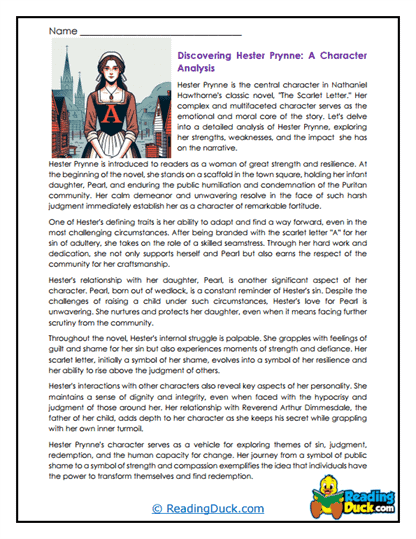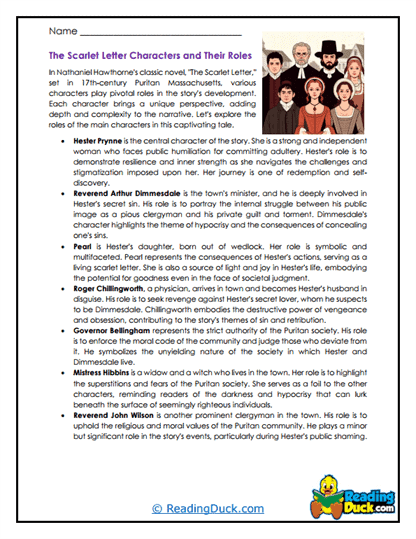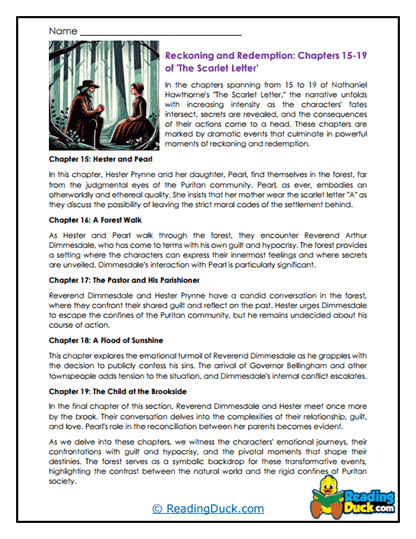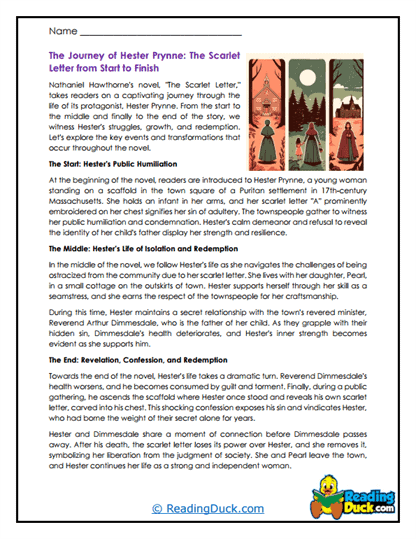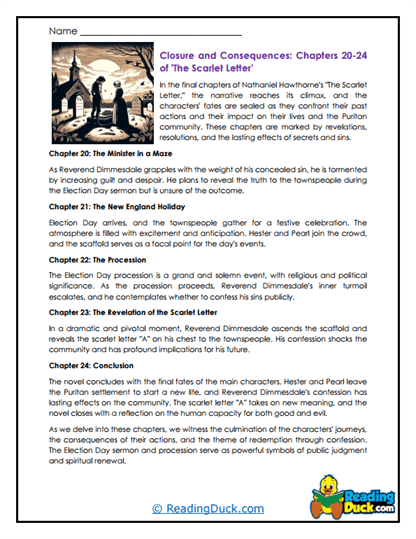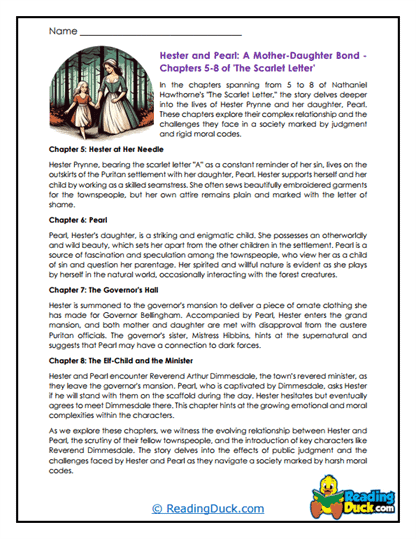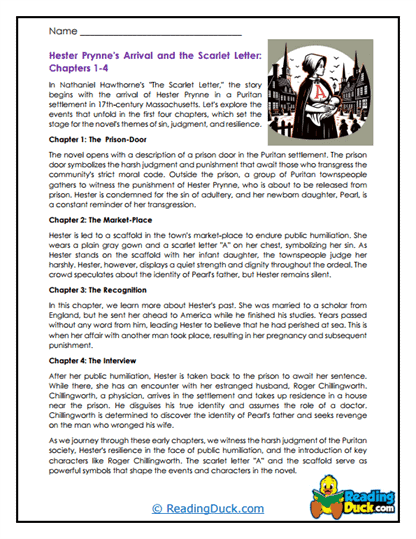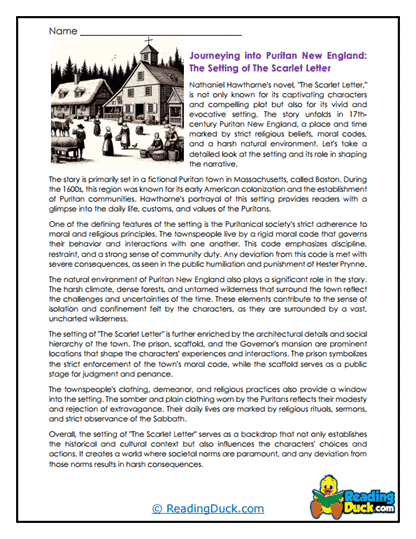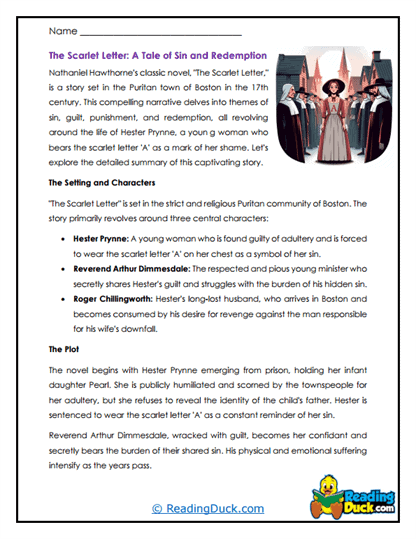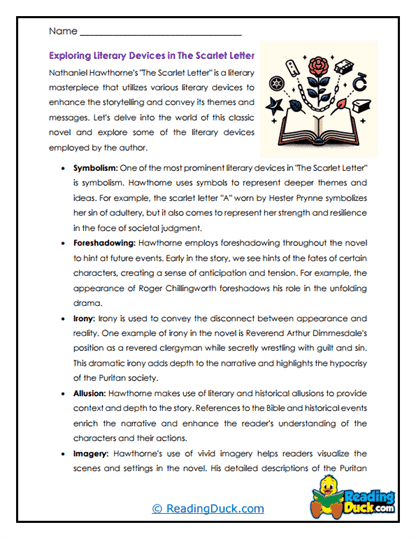The Scarlet Letter Worksheets
About Our The Scarlet Letter Worksheets
Our The Scarlet Letter worksheets offer a comprehensive and engaging exploration of Nathaniel Hawthorne’s classic novel, guiding students through its complex themes, rich symbolism, and deep character studies. These worksheets are crafted to encourage critical thinking, literary analysis, and a personal connection to the text, making them an essential resource for any literature curriculum.
The Literature category that includes The Scarlet Letter also encompasses a variety of other notable and classical works, such as 1984, Fahrenheit 451, Lord of the Flies, Of Mice and Men, Pride and Prejudice, Romeo and Juliet, The Diary of Anne Frank, The Great Gatsby, and To Kill a Mockingbird. Each collection is carefully organized to provide an in-depth study of one literary work at a time, ensuring that students gain a thorough understanding of key themes, character development, and the broader societal implications of these texts.
Each category features several worksheet sets, each focusing on different aspects of the literary work. For The Scarlet Letter, these worksheet sets include:
- Multiple Choice Questions: These questions help students grasp the basic plot, characters, and themes of the novel. By answering these questions, students can demonstrate their comprehension of the text and identify key elements that are crucial to understanding the story.
- Short Answer Questions: This format encourages students to delve deeper into the text, allowing them to analyze characters, themes, and significant events in their own words. These questions are designed to challenge students to think critically and express their interpretations clearly.
- Open-Ended Questions: These questions invite students to reflect on their personal thoughts, opinions, and feelings about the novel. By engaging with the material on a personal level, students can develop a stronger connection to the text and enhance their ability to articulate their ideas.
Each worksheet set is designed to assess students’ understanding of the material while encouraging them to engage deeply with the text. An answer key is provided for every question sheet, ensuring that educators can easily assess student progress. All worksheets are available as PDF files, which can be easily viewed electronically, downloaded, and printed.
Exploring The Scarlet Letter: A Study in Sin, Guilt, and Redemption
When introducing The Scarlet Letter to students, it’s important to emphasize that this novel is not just a story of historical fiction; it’s a profound exploration of sin, guilt, and the complex nature of human morality set against the backdrop of Puritan New England.
Key Aspects of The Scarlet Letter to Understand:
- Sin and its Consequences: One of the central themes of The Scarlet Letter is the concept of sin and its consequences. The novel examines how different characters respond to sin—Hester Prynne’s public shaming, Reverend Dimmesdale’s hidden guilt, and Roger Chillingworth’s consuming revenge. This theme allows students to explore the moral and social implications of sin, the nature of repentance, and the potential for redemption.
- The Nature of Guilt and Redemption: Hawthorne delves deep into the psychological effects of guilt and the possibility of redemption. Hester, who wears her guilt publicly with the scarlet letter, contrasts with Dimmesdale, who suffers privately, leading to profound physical and mental anguish. This exploration prompts students to consider how guilt manifests and whether true redemption is possible through personal actions, public confession, or divine forgiveness.
- The Role of Society and Judgment: The novel presents a powerful critique of societal norms and the harsh judgment that can accompany deviation from those norms. The Puritan community’s treatment of Hester reflects the rigid and often unforgiving nature of societal expectations. This aspect of the novel can lead to discussions about the role of society in shaping individual behavior, the impact of public shaming, and the balance between justice and compassion.
- Symbolism and Imagery: The Scarlet Letter is rich with symbolism, from the scarlet letter “A” itself to the wild rosebush outside the prison door. These symbols enhance the novel’s themes and provide layers of meaning that deepen the reader’s understanding of the characters and their struggles. Students can explore how Hawthorne uses symbolism to convey complex ideas about sin, identity, and human nature.
- Puritanism and Hypocrisy: The novel is set in a deeply religious Puritan society that emphasizes strict moral codes and a clear delineation between good and evil. However, Hawthorne reveals the hypocrisy that often lies beneath this outward piety, particularly in the character of Reverend Dimmesdale. This theme encourages students to think critically about the difference between public persona and private reality, and the ways in which societal pressure can lead to hypocrisy.
- Gender Roles and Feminism: Hester Prynne’s character can be examined through the lens of gender roles and early feminist thought. Despite her ostracization, Hester displays remarkable strength, independence, and resilience, challenging the traditional expectations of women in her society. Students can discuss how Hester’s character defies the limitations placed on women and what her story suggests about the role of women in society, both in Hawthorne’s time and today.
By exploring these themes and characters, students can gain a deeper understanding of The Scarlet Letter and its exploration of sin, guilt, redemption, and the complexities of human morality. The novel challenges readers to reflect on the nature of judgment, the power of societal norms, and the potential for forgiveness and transformation.
Impact and Legacy of The Scarlet Letter
Nathaniel Hawthorne’s The Scarlet Letter has had a profound impact on American literature and culture since its publication in 1850. The novel’s exploration of sin, guilt, and redemption in a rigidly moralistic society has resonated with readers for generations, making it one of the most enduring works in American literary history.
Socio-Cultural History:
- Puritan New England: The Scarlet Letter is set in the Puritan society of 17th-century Massachusetts, a community characterized by strict religious beliefs, moral absolutism, and a strong emphasis on public piety. Hawthorne’s depiction of this society provides a critical lens through which to examine the influence of Puritanism on American culture, particularly in terms of its attitudes toward sin, punishment, and redemption. The novel serves as a historical exploration of how these early American values shaped societal norms and individual behavior.
- Moral and Religious Critique: Hawthorne’s novel is often seen as a critique of the moral rigidity and hypocrisy that can arise in a society governed by strict religious doctrines. By highlighting the contrast between the public condemnation of Hester Prynne and the hidden sins of other characters, Hawthorne challenges the notion of moral superiority and questions the fairness of societal judgment. This critique has made The Scarlet Letter a key text in discussions about the relationship between religion, morality, and justice.
Cultural Impact:
- Literary Influence: The Scarlet Letter has influenced countless writers and works of literature, particularly in the genres of psychological fiction and moral allegory. The novel’s exploration of the human psyche, its use of symbolism, and its deep moral questions have inspired a wide range of literary works that deal with similar themes. Hawthorne’s emphasis on the inner lives of his characters and the moral complexities they face has made The Scarlet Letter a model for character-driven, introspective fiction.
- Adaptations and Interpretations: The novel has been adapted into numerous films, stage productions, and even operas, each bringing a new perspective to Hawthorne’s story. These adaptations have helped to keep The Scarlet Letter relevant for new generations of readers, demonstrating its enduring appeal and the timeless nature of its themes. From traditional period adaptations to more modern interpretations, these versions highlight the novel’s versatility and its ability to resonate across different cultures and time periods.
- Relevance Today: Despite being over 170 years old, The Scarlet Letter remains highly relevant today. The novel’s exploration of themes such as sin, judgment, and the complexity of human morality continues to resonate with modern audiences. Its critique of societal norms and the consequences of public shaming make it a powerful tool for understanding contemporary issues related to justice, forgiveness, and the role of women in society.
Enduring Legacy:
The Scarlet Letter is more than just a novel; it is a profound exploration of sin, guilt, and redemption, set against the backdrop of a rigidly moralistic society. Its themes continue to resonate today, making it a powerful tool for understanding the complexities of human morality, the impact of societal norms, and the potential for forgiveness and transformation. The novel’s legacy is evident in its continued popularity, its influence on American literature and culture, and its role in shaping our understanding of the human condition.
Encouraging Students to Appreciate Literature
As educators, one of our most important tasks is to help students develop an appreciation for literature. Literature opens up new worlds, perspectives, and ideas, helping students develop empathy, critical thinking skills, and a deeper understanding of the human experience. Here are some tips on how teachers and parents can use these The Scarlet Letter worksheets to encourage students to engage more deeply with literature:
Using Worksheets Effectively:
- Facilitate Engaging Discussions: After students complete the worksheets, encourage them to discuss their answers and interpretations of the text. The open-ended questions are particularly effective for sparking thoughtful discussions about the novel’s themes, characters, and social commentary. By engaging in these discussions, students can gain new insights and deepen their understanding of the text.
- Draw Parallels to Real Life: Help students connect the themes of The Scarlet Letter to real-world situations. Discuss how the novel’s exploration of sin, judgment, and redemption relates to current events, historical examples, or personal experiences. This approach can help students see the relevance of literature in understanding the world around them.
- Encourage Creative Expression: Motivate students to engage with the novel creatively. They might create a modern adaptation of a key scene, design a visual representation of the novel’s symbols, or write a diary entry from the perspective of one of the characters. These creative projects allow students to express their understanding of the text in unique and personal ways, making the literature more tangible and exciting.
- Incorporate Group Work: Use the worksheets as a basis for group activities. Students can work together to answer questions, analyze characters, or perform scenes from the novel. Group work encourages collaboration and allows students to learn from each other’s perspectives and interpretations.
- Foster Personal Reflections: Encourage students to keep a reading journal where they can reflect on their thoughts and feelings about the novel. The open-ended questions from the worksheets can serve as prompts for these reflections, helping students connect personally with the material and develop a deeper appreciation for the themes explored in The Scarlet Letter.
Creating a Literary Environment:
- Build a Classroom Library: Stock your classroom or homeschool environment with a variety of books, including other works by Nathaniel Hawthorne and related literature that explores similar themes. This encourages students to explore beyond the assigned reading and discover new authors and genres that interest them.
- Hawthorne Study: Consider doing a broader study on Nathaniel Hawthorne’s works. Explore his life, other novels like The House of the Seven Gables or Young Goodman Brown, and his influence on American literature. This can provide students with a broader context for understanding The Scarlet Letter and appreciating Hawthorne’s contributions to the literary world.
- Host Literature Circles: Organize literature circles where students can discuss the novel in small groups. Assign each group a specific aspect of the novel to focus on, such as character development, symbolism, or thematic analysis. This allows students to delve deeper into the text and share their insights with their peers.
By using these strategies, teachers and parents can help students develop a deeper appreciation for literature and inspire a lifelong love of reading. The Scarlet Letter worksheets are a valuable tool in this process, providing a structured yet flexible way to explore one of the most important novels in American literature. Through these activities, students will not only understand the content of The Scarlet Letter but also connect with its themes and messages on a personal level, enriching their educational experience.
